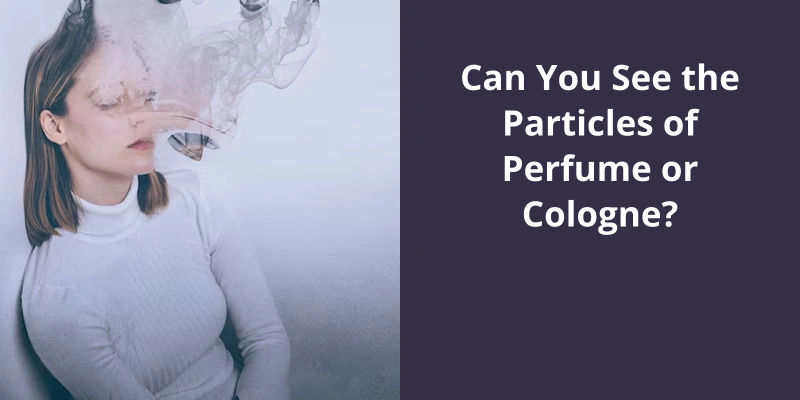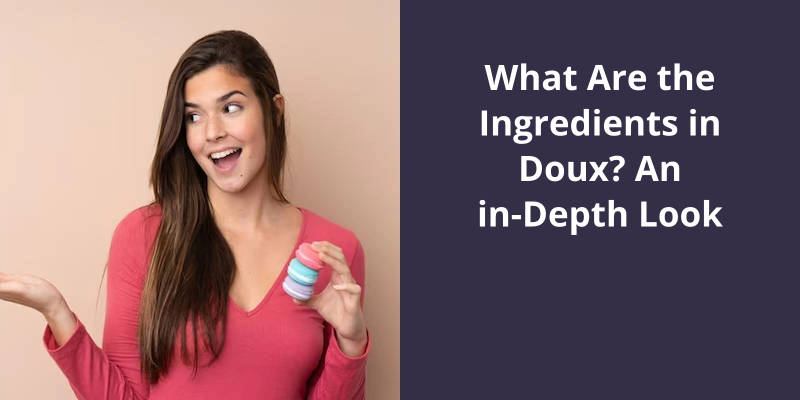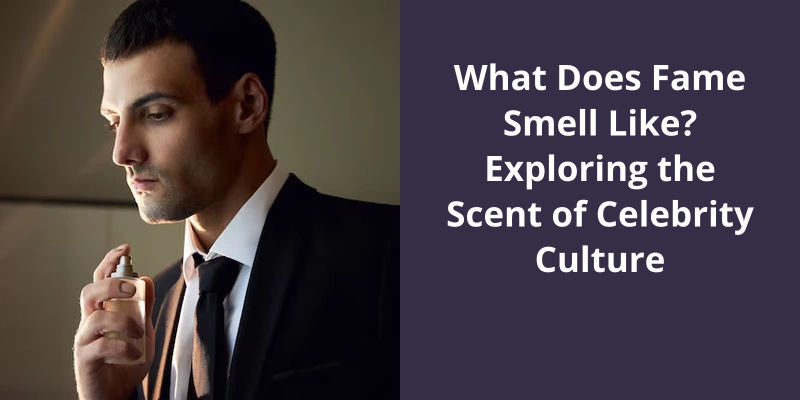No, you cannot see the particles of perfume or cologne with the naked eye. These particles are extremely tiny and float in the air when you spray the fragrance. They then settle on your skin or clothing, leaving behind the scent. While you can’t see these particles, you can certainly smell them, which is how we experience fragrances. Even though they are invisible, these scent particles play a crucial role in giving a perfume or cologne its characteristic smell.

How Do Perfume Particles Diffuse Around a Room?
The particles of perfume or cologne are incredibly small, often on a nanoscale level, making them nearly invisible to the naked eye. These tiny particles are a result of the fragrance being released into the air, where they interact with other air particles through a process known as diffusion.
Diffusion is a natural phenomenon where molecules move from an area of high concentration to an area of low concentration. In the case of perfume or cologne, it means that the fragrance particles spread out and disperse throughout the room, creating a pleasant scent that can be detected by our noses.
These particles are incredibly small, measuring in the nanometer range, which is thousands of times smaller than the width of a human hair. This renders them practically invisible to the human eye, even when they’re diffusing throughout a room.
While we can’t see perfume particles directly, we can observe their effects. The dispersal of fragrance particles throughout a room is evident when we catch a whiff of the scent in different areas. Additionally, if you were to spray perfume in a specific spot in a room, you might notice the scent gradually spreading and becoming noticeable in other areas over time. This diffusion process allows us to experience the fragrance of perfumes and colognes even if we cant physically see the particles themselves.
The Science of Perfume Composition: Exploring the Different Ingredients and Components That Make Up a Perfume and How They Interact With Each Other.
The science of perfume composition involves exploring the different ingredients and components that make up a perfume and how they interact with each other. Perfumes are made up of a mixture of various aromatic compounds, solvents, and fixatives. These components work together to create the desired scent and ensure it’s longevity.
Perfume ingredients can include natural substances such as essential oils extracted from flowers, fruits, leaves, or woods, as well as synthetic compounds that mimic these natural scents. These ingredients are carefully selected and blended in specific proportions to achieve the desired fragrance profile.
When applied to the skin, the volatile molecules in perfume evaporate and interact with the body’s natural oils and heat, releasing the fragrance into the air. This is why the scent of a perfume can vary from person to person.
While the particles of perfume or cologne themselves may not be visible to the naked eye, their scent can be detected by our olfactory system, which is highly sensitive to various odor molecules. So, although we can’t see the particles of perfume, we can certainly experience their aromatic presence.
Understanding the science behind perfume composition can give us insights into the intricate art of fragrance creation and appreciation.
One way to determine if your cologne has gone bad is by observing any changes in it’s color. Over time, perfume often tends to darken and may appear murky or opaque. Therefore, closely examining the liquid inside your bottle for any significant shifts in color can help you determine if it’s time to discard it.
How Do You Know if Cologne Has Gone Bad?
One of the first signs that a cologne has gone bad is a change in it’s scent. Perfumes and colognes are made up of a complex blend of ingredients, and over time, these ingredients can break down and degrade. This can result in a noticeable change in the fragrance.
As perfumes age, they can become thicker or more watery, depending on the specific formula.
When determining if your cologne has gone bad, it’s also important to consider how it’s been stored. Exposure to excessive heat or sunlight can accelerate the breakdown of the fragrance molecules, causing the cologne to go bad more quickly. If you’ve been storing your cologne in a warm or sunny location, it may become spoiled sooner than if it had been kept in a cool, dark place.
While perfumes and colognes don’t have a specific expiration date, their quality and effectiveness can deteriorate over time. It’s always best to trust your senses and err on the side of caution when it comes to using old or spoiled cologne.
How Can You Properly Store Cologne to Extend It’s Shelf Life?
- Keep cologne bottles tightly closed when not in use.
- Store cologne in a cool and dark place to avoid exposure to sunlight and heat.
- Avoid storing cologne in the bathroom, as the moisture and temperature fluctuations can degrade it’s quality.
- Consider transferring cologne to smaller, opaque bottles to minimize air exposure.
- Avoid storing cologne near sources of heat or intense light, such as radiators or windows.
- Don’t store cologne in the refrigerator, as the low temperatures can alter it’s fragrance.
- Keep cologne away from direct contact with clothing, as it may cause stains or discoloration.
- Replace the cap or stopper tightly after each use to prevent air and moisture from entering the bottle.
- Avoid shaking cologne bottles excessively, as this can introduce air into the liquid and accelerate it’s oxidation.
- Regularly check the expiration date of cologne and discard any that’s exceeded it’s shelf life.
Source: 3 Ways to Tell If Your Perfume Is Past It’s Expiration Date
Counterfeit perfumes pose a significant risk, as they can contain harmful substances such as urine, bacteria, and antifreeze. These unregulated imitations not only compromise the quality of the fragrance, but they can also present health hazards. Let’s delve into the alarming reality of potential bacterial contamination in perfumes and explore the adverse effects it can have on consumers.
Can Perfume Have Bacteria in It?
Perfumes and colognes are popular choices for personal grooming, but have you ever wondered about the particles present in these scented liquids? While the focus is often on the aromatic molecules that give perfumes their delightful fragrances, it’s essential to consider the overall quality and safety of these products.
One aspect that concerns experts is the potential presence of bacteria in perfumes. Counterfeit or substandard perfumes, which can pose significant health risks, may contain harmful substances such as urine, bacteria, or even antifreeze. These substances can find their way into counterfeit products due to poor manufacturing practices or improper storage conditions. Therefore, it’s crucial to purchase perfumes from reputable sources to ensure their quality and safety.
To prevent the use of counterfeit perfumes and safeguard your health, it’s advisable to follow a few guidelines. Firstly, buy perfumes from authorized retailers or directly from the manufacturer. Secondly, pay attention to the packaging and ensure it appears authentic and undamaged. Additionally, be cautious of excessively low prices, as they may indicate counterfeit products.
When it comes to personal hygiene products like perfumes, it’s essential to prioritize your health and well-being. Remember, the delightful scent of a perfume shouldn’t come at the cost of your health; choose wisely and stay safe.
The Potential Health Risks of Using Counterfeit Perfumes
Using counterfeit perfumes can pose potential health risks to individuals. Counterfeit perfumes often contain harmful ingredients such as toxic chemicals, heavy metals, and even urine or bacteria. These substances can cause allergic reactions, skin irritations, respiratory issues, and other health problems. Moreover, because counterfeit products are produced illegally, their quality and safety can’t be guaranteed. It’s essential to purchase perfumes from reputable sources to ensure that you aren’t exposed to these health risks.
Conclusion
In conclusion, delving into the realm of scent and it’s ethereal nature poses intriguing questions about our perception of the invisible particles that compose perfumes and colognes. While these aromatic compounds are inherently imperceptible to the naked eye, their presence can be inferred through various sensory experiences and scientific knowledge. From the evocative power of fragrances to the intricacies of olfactory research, the world of scents invites us to engage in a sensory exploration that goes beyond the scope of what can be seen. So, although we may not be able to visually witness the particles of perfume or cologne, their effects and influence on our lives are undeniable and captivating.





